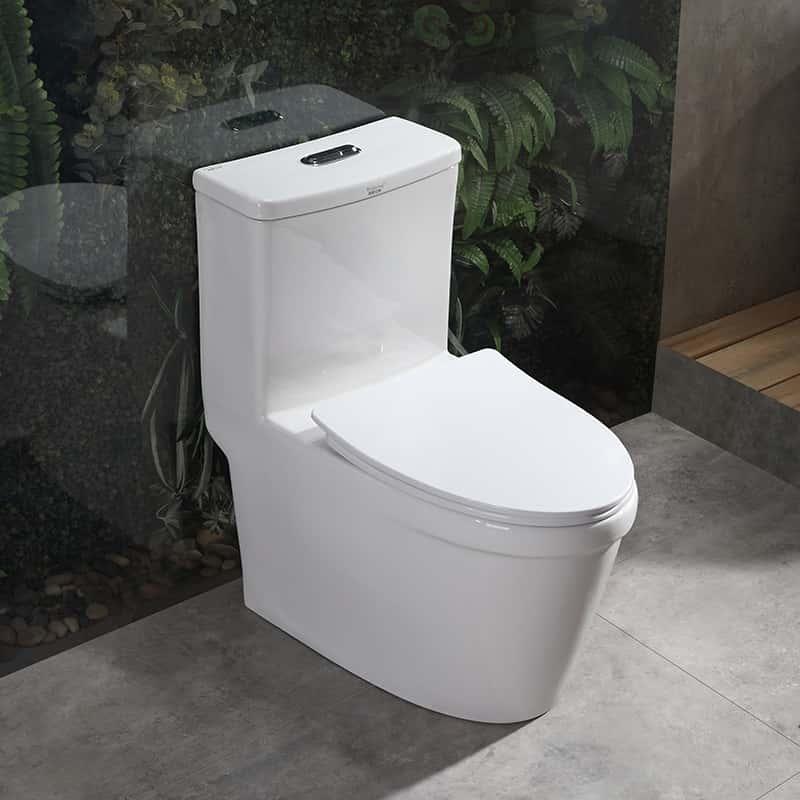Siphonic toilet bowls are essential in modern bathrooms due to their powerful flushing capabilities. Unlike traditional toilets that rely solely on gravity, siphonic toilets use a combination of water and air pressure for a more effective flush.
This design helps reduce clogs and maintain a cleaner bowl. Understanding the mechanics behind a siphonic one piece toilet reveals how this technology enhances bathroom hygiene.
The Basics of Siphonic Flushing
A siphonic toilet bowl features an S-shaped trapway that creates a siphoning effect during flushing. When the flush is activated, water from the tank rapidly enters the bowl through the rim and jet holes. This sudden influx of water fills the bowl and moves through the trapway. The S-shaped design allows water to gain momentum, creating a vacuum that helps pull waste down and out.
This siphonic action effectively clears the bowl of waste. It sets these toilets apart from other types, such as washdown toilets, which primarily rely on gravity. A siphonic toilet provides a more efficient flush, reducing the likelihood of clogs and incomplete flushing.
How Siphonic Toilets Create a Powerful Flush
The power of a siphonic flush comes from the combination of water flow and air pressure. When you press the flush lever, a valve opens, releasing water from the tank into the bowl.
This water flows through the rim holes and the jet at the bottom of the bowl, quickly increasing the water level. As the water level rises, it creates a seal over the trapway, forming the necessary vacuum.
Once the trapway fills with water, the siphoning effect begins. The S-shape of the trapway creates a drop in pressure that pulls water and waste through the system. This process ensures that waste is efficiently removed and carried into the drainpipe, maintaining bowl cleanliness with each flush.
Water Efficiency and Siphonic Toilets
Siphonic toilets are designed for water efficiency, making them an eco-friendly choice. Using a combination of water and air pressure, these toilets can achieve a powerful flush with less water.
Modern siphonic toilets often use 1.28 gallons per flush (GPF) or less, meeting water conservation standards. This efficient use of water conserves resources and reduces utility bills.
The design minimizes the need for multiple flushes, further conserving water. The powerful siphonic action also reduces the necessity for chemical cleaners and plunging, as clogs are less frequent.
This makes siphonic toilets a sustainable and cost-effective option. Their ability to maintain bowl cleanliness with minimal water use is a significant advantage.
The Role of the Siphon Jet
A key component of many siphonic toilets is the siphon jet, a small opening at the bottom of the bowl. During a flush, water is directed into this jet, sending a concentrated stream of water into the trapway.
This jet action accelerates the siphoning process by quickly filling the trapway and creating the necessary vacuum. The syphon jet toilet has a reputation for powerful flushing because of this rapid action.
The siphonic jet toilet enhances flushing power and helps guide waste into the trapway. This reduces the chance of waste sticking to the bowl, promoting a more hygienic experience.
The strategic placement of the siphon jet makes siphonic toilets particularly effective at reducing clogs. The combination of jet propulsion and siphonic action ensures waste is efficiently removed.
Maintenance and Clog Reduction
Siphonic toilet bowls are known for reducing clogs. The powerful flush created by the siphon effect clears waste more effectively than gravity-fed toilets.
The S-shaped trapway design allows waste to pass through more easily, reducing the chances of blockages.
Siphon toilet seats also play a role in hygiene and maintenance. The thorough flush leaves less residue behind, decreasing the need for frequent cleaning. Additionally, this reduces the need for harsh chemical cleaners.
This makes it easier to maintain the toilet and contributes to a more environmentally friendly cleaning routine. With fewer clogs, there’s less reliance on plungers, making siphonic toilets convenient for households.
The Impact on Bathroom Hygiene
The efficient flushing mechanism of siphonic toilets is crucial for bathroom hygiene. By effectively removing waste with each flush, these toilets minimize the presence of bacteria and odors. <Learn toilet flush mechanism types>
The quick and thorough clearing of waste reduces the risk of bacteria multiplying and spreading, resulting in a more sanitary bathroom.
In public restrooms, using syphon jet toilets can significantly improve cleanliness. The reduced risk of clogs and the need for fewer flushes make for a more hygienic experience for users.
This technology also meets the demand for eco-friendly bathroom solutions. By providing a powerful flush while conserving water, siphonic toilets set a new standard in bathroom hygiene.
Conclusion
Siphonic toilet bowls represent an advancement in flushing technology by using water and air pressure for a powerful and efficient flush. Their design reduces clogs and promotes a cleaner bathroom environment. By using water more efficiently, siphonic toilets support conservation efforts while maintaining high performance.
As we seek ways to improve bathroom hygiene and efficiency, siphonic toilets offer valuable insights into future toilet design. They provide a reliable and eco-friendly solution for maintaining cleanliness. Understanding how siphonic toilet bowls work helps us appreciate their role in our daily bathroom experience.

